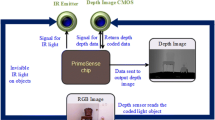Abstract
In image-based global localization, a robot pose is estimated through image association when the robot revisits a previously visited location on a map. Image association is typically performed using high-level local features such as scale invariant feature transform (SIFT) and speeded up robust feature (SURF). However, these methods suffer from false-positive association and high computational load to reject outliers. In this study, we introduce a novel global localization method based on the proposed low-frequency image-based descriptor (LFID) and laser range data. The image is first processed by reducing the range of luminance in the frequency domain. Visual features are then extracted from the processed image through a kernel window. These visual features are described as binary representation for fast association. Because this binary representation includes a spatial distribution of features, it can minimize false-positive association. Nevertheless, false-positive association could occur when scenes appear to be similar from different viewpoints. To address this problem, this study adopts a laser rangefinder to validate the similarity of the place and reject false-positives from the scene recognition. Experimental results confirm the effectiveness of the proposed scheme in actual indoor environments.
Similar content being viewed by others
References
P. Henry, M. Krainin, E. Herbst, X. Ren, and D. Fox, “RGB-D mapping: using kinect-style depth cameras for dense 3D modeling of indoor environments,” Int. Journal of Robotics Research, vol. 35, no. 5, pp. 647–663, 2012. [click]
D. Fox, S. Thrun, W. Burgard, and F. Dellaert, “Particle filters for mobile robot localization,” Sequential Monte Carlo methods in Practice, Springer, New York, pp. 401–428, 2001. [click]
M. Jung and J. B. Song, “Efficient autonomous global localization for service robots using dual laser scanners and rotational motion,” Int. Journal of Control, Automation and Systems, vol. 15, no. 2, pp. 743–751, 2017. [click]
J. Wolf, W. Burgard, and H. Burkhardt, “Robust visionbased localization by combining an image-retrieval system with Monte Carlo localization,” IEEE Trans. on Robotics, vol. 21, no. 2, pp. 208–216, 2005. [click]
M. Cummins and P. Newman, “FAB-MAP: probabilistic localization and mapping in the space of appearance,” Int. Journal of Robotics Research, vol. 27, no. 6, pp. 647–665, 2008. [click]
M. Labbe and F. Michaud, “Online global loop closure detection for large-scale multi-session graph-based slam,” IEEE/RSJ Int. Conf. on Intelligent Robots and Systems, pp. 2661–2666, 2014.
K. L. Ho and P. Newman, “Detecting loop closure with scene sequences,” Int. Journal of Computer Vision, vol. 74, no. 3, pp. 261–286, 2007. [click]
J. Sivic and A. Zisserman, “Video Google: a text retrieval approach to object matching in videos,” Int. Conf. on Computer Vision, pp. 1470–1477, 2003. [click]
H. Bay, T. Tuytelaars, and L. Van Gool, “Surf: speeded up robust features,” Computer Vision-ECCV, Springer Berlin Heidelberg, pp. 404–417, 2006. [click]
D. G. Lowe, “Distinctive image features from scaleinvariant keypoints,” Int. Journal of Computer Vision, vol. 60, no. 2, pp. 91–110, January 2004. [click]
E. Rublee, V. Rabaud, K. Konolige, and G. Bradski, “ORB: an efficient alternative to SIFT or SURF,” IEEE Int. Conf. on Computer Vision, pp. 2564–2571, 2011. [click]
R. Mur-Artal and J. D. Tardós, “ORB-SLAM2: an opensource SLAM system for monocular, stereo, and RGB-D cameras,” IEEE Trans. on Robotics, vol. 33, no. 5, pp. 1255–1262, 2017. [click]
D. Gálvez-López and J. D. Tardos, “Bags of binary words for fast place recognition in image sequences,” IEEE Trans. on Robotics, vol. 28, no. 5, pp. 1188–1197, 2012. [click]
D. Schlegel and G. Grisetti, “Visual localization and loop closing using decision trees and binary features,” IEEE/RSJ Int. Conf. on Intelligent Robots and Systems, pp. 4616–4623, 2016.
J. Heinly, E. Dunn, and J. M. Frahm, “Comparative evaluation of binary features,” Computer Vision-ECCV, Springer, Berlin, Heidelberg, pp. 759–773, 2012.
P. Pinies, L. M. Paz, D. Galvez-Lopez, and J. D. Tardos, “CI-Graph SLAM for 3D reconstruction of large and complex environments using a multicamera system,” Journal of Field Robotics, vol. 27, no. 5, pp. 561–586, 2010. [click]
M. A. Fischler and C. B. Robert, “Random sample consensus: a paradigm for model fitting with applications to image analysis and automated cartography,” Communications of the ACM, vol. 24, no. 6, pp. 381–395, June 1981. [click]
M. J. Milford and G. F. Wyeth, “SeqSLAM: visual route-based navigation for sunny summer days and stormy winter nights,” IEEE Int. Conf. on Robotics and Automation, pp. 1643–1649, 2012. [click]
A. S. Glassner, An Introduction to Ray Tracing, Elsevier, 1989.
P. J. Besl and N. D. McKay, “A method for registration of 3-D shapes,” IEEE Trans. on Pattern Analysis and Machine Intelligence, vol. 14, no. 2, pp. 239–256, 1992. [click]
Author information
Authors and Affiliations
Corresponding author
Additional information
Recommended by Associate Editor Dong-Joong Kang under the direction of Editor Fuchun Sun. This research was supported by the MOTIE under the Industrial Foundation Technology Development Program supervised by the KEIT (No. 10084589).
Chansoo Park received his B.S. degree in Computer and Information Science from Korea University in 2012. He is now an M.S. and Ph.D. candidate in the School of Mechatronics at Korea University. His research includes robot navigation, computer vision, and software engineering.
Jae-Bok Song received his B.S. and M.S. degrees in Mechanical Engineering from Seoul National Univ., Seoul, Korea, in 1983 and 1985, respectively, and his Ph.D. degree in Mechanical Engineering from MIT, Cambridge, MA, in 1992. He joined the faculty of the Department of Mechanical Engineering, Korea University, Seoul, Korea in 1993. His current research interests are the design and control of robot arms and robot navigation systems.
Rights and permissions
About this article
Cite this article
Park, C., Song, JB. Global Localization Using Low-frequency Image-based Descriptor and Range Data-based Validation. Int. J. Control Autom. Syst. 16, 1332–1340 (2018). https://doi.org/10.1007/s12555-016-0491-y
Received:
Revised:
Accepted:
Published:
Issue Date:
DOI: https://doi.org/10.1007/s12555-016-0491-y




